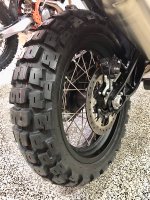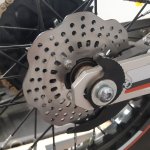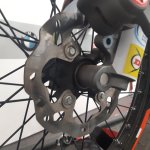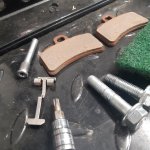New rubber on the 1290R. Replaced the oem AX41woth a Motoz Adventure. First bike I ever killed a rear tire on in 3000kms 
You are using an out of date browser. It may not display this or other websites correctly.
You should upgrade or use an alternative browser.
You should upgrade or use an alternative browser.
What did you do in your garage today..?
- Thread starter Hack
- Start date
New rubber on the 1290R. Replaced the oem AX41woth a Motoz Adventure. First bike I ever killed a rear tire on in 3000kms
Looks the business.
 Tubeless?
Tubeless?Yup. Supposedly super strong so should be pretty puncture resistant.Looks the business.Tubeless?
Mad Mike
Well-known member
Good advice, but starting with TIG is expensive and not so easy.Welder advice: No matter what you buy, you regret not buying a bigger/better one.
... that means there are always lots of great deals on used welders
... and if you plan on welding motorcycle stuff, get a TIG
... and not to a welder snob, but buy name brand, that way when the thing breaks down you can get parts... and new welders gots more bells and whistles than new cars. I learned on a welder with 3 settings: amperage, on, off. My current TIG looks like a jet cockpit
I've tried a bunch of cheapo MIG welders, were all great. For a beginner, I'd buy a 120V synergic inverter Flux-core MIG off Amazon, <$200. Welding 14 gauge steel and stainless up to 3/16" is doable for a beginner with one of these welders. If you're dead set on brand names, buy from a welding store -- the Lincoln MigPaks sold at CTC & HD are made for big box stores -- no different than any cheap Chinese welder - not worth the $500 premium (we have one, it's junk).
- Mig and stick are easy to learn. TIG is not as easy.
- Stick and flux-core Mig weld without gas. TIG and MIG need gas. A bottle costs $350-$500. Welding uses about 15CFM/hr or about $10 of gas/hr when you're on the trigger.
- Flux core can be messy -- plenty of splatter, soot, and burn holes on thin metal. Mig and Arc are better, TIG is the cleanest.
- Flux core welding thin metals (under 14guage) is hard, MIG, Arc, TIG handle 24guage before getting tricky.
- Wire and rod prices for all of them are relatively cheap for steel welding.
- Stick and flux-core Mig welds can be done outdoors, TIG and MIG likes to be done inside (zero breeze)
Mad Mike
Well-known member
They will pop a 15A breaker after about a minute on high. Most welding is on and off the trigger, if you're running 30% duty cycle in a 2 minute period -- I doubt you'll pop a breaker.Does yours use a regular 15A plug? I've only got 15A circuits in the garage to work with, and I wasn't clear if the larger units require a 20A circuit (eg: the cheapo PowerFist fluxcore machine has a max amperage draw of 23A. Even the mini stick machine has a max draw of 20A, but has a 15A plug on it).
edit: the manuals for both of these say they require a 20A circuit, despite the 15A plug on the little one.
Is a flux core machine easier to use or significantly better at some things than stick? Skill-wise, I'm guessing the main difference is just figuring out the wire feed rate?
Cheaper to aim an air conditioning duct at your breaker panel than it is to upgrade wiring.They will pop a 15A breaker after about a minute on high. Most welding is on and off the trigger, if you're running 30% duty cycle in a 2 minute period -- I doubt you'll pop a breaker.
True, but for us motorcycle folks, TIG is infinitely more useful.but starting with TIG is expensive and not so easy
Not easy? nothing is easy. It is "easier" to bodge two steel plates together with a MIG than a TIG, but it's not welding.
I've got a pulse AC/DC... and using pulse on steel feels like cheating... it's comparatively EASY (I grew up gas welding, so TIG came kinda natural. I can't stick or MIG to save my life. But the day I brought home my current machine, I welded two razor blades together (nice bead if I say do so myself, IIRC about 12v/ 2A) cuz that's what one does, and that was before I figured out you could use pulse on steel)
Stickin two pieces of steel together is "easier" with a MIG, learning how to weld them together is much steeper curve, no matter what process. TIG has a gas pedal, MIG doesn't (gas pedal like in your car, to make it faster or slower, not an argon gas pedal)
And there's no el'cheapo MIGs with a 30% duty cycle, more like 5 -10%, so no more than 6 minutes an hour, with lots of time to cool, or you blow fuses... glorified spot welders. A 30% welder is not going to be cheap.
Mad Mike
Well-known member
Hard to say what’s more useful. I’d sharpen up my TIG if I was doing metal finish work, building tanks or repairing cases, but for fabricating or repairing steel stuff, I like the ease, versatility, speed of MIG (TIG is sloooow).True, but for us motorcycle folks, TIG is infinitely more useful.
Not easy? nothing is easy. It is "easier" to bodge two steel plates together with a MIG than a TIG, but it's not welding.
I've got a pulse AC/DC... and using pulse on steel feels like cheating... it's comparatively EASY (I grew up gas welding, so TIG came kinda natural. I can't stick or MIG to save my life. But the day I brought home my current machine, I welded two razor blades together (nice bead if I say do so myself, IIRC about 12v/ 2A) cuz that's what one does, and that was before I figured out you could use pulse on steel)
Stickin two pieces of steel together is "easier" with a MIG, learning how to weld them together is much steeper curve, no matter what process. TIG has a gas pedal, MIG doesn't (gas pedal like in your car, to make it faster or slower, not an argon gas pedal)
And there's no el'cheapo MIGs with a 30% duty cycle, more like 5 -10%, so no more than 6 minutes an hour, with lots of time to cool, or you blow fuses... glorified spot welders. A 30% welder is not going to be cheap.
As for duty cycle, unless you’re fabricating really big stuff at full power the 140a cheapies won’t blow thru their duty cycle. It should run 1’ of continuous bead a minute on 3/16 material and non stop 1/8. Remember mig moves way faster than TIG, so your on the trigger much less.
New plugs in wife's car. Front three take five minutes. Rear three require removing intake and a bunch of other stuff. Wasn't too bad though.
Sharpened some more skiis. All skiis are now ready and on the wall. I can't remember if I did the snowboards before I put them away. I have at least one to do and maybe up to three more if I was lazy. New storage system works well. Old system only held four sets. New system holds 18 sets. The old one came with the house and they obviously painted the garage with it up. :/

Sharpened some more skiis. All skiis are now ready and on the wall. I can't remember if I did the snowboards before I put them away. I have at least one to do and maybe up to three more if I was lazy. New storage system works well. Old system only held four sets. New system holds 18 sets. The old one came with the house and they obviously painted the garage with it up. :/

Malks
Well-known member
I like it. Thanks for the reminder; I need to sharpen and wax my skis. I usually do that after the season and then just scrape them in the fall but just didn't get around to it this year.Sharpened some more skiis. All skiis are now ready and on the wall.

I got a bunch done in the spring but not all. Temps climbed and tuning skiis in a hot garage is not fun. Like you, I try to get them done in the spring to protect them and then scrape them just before using them. Picked up a few more sets for the kids cheap as one kid didn't like the larger skiis I bought them. I think they were great and the kid is good enough for them but lacks the confidence to push and really lean on them so the slalom skiis just ended up being heavy and scary. The replacement skiis are much lighter and lazier (and twin-tips).I like it. Thanks for the reminder; I need to sharpen and wax my skis. I usually do that after the season and then just scrape them in the fall but just didn't get around to it this year.
Gotta chime in on the welding. I have a cheap CTC flux core machine and it's GREAT! It been invaluable on my latest project. I've said it before, the power to join metal is near magical.
HOWEVER, I needed more wire so I grabbed two 2lb rolls of Powerweld that was on sale at PA for $16 each. When I couldn't lay a bead I thought the popping and farting was something in my substrate (like trying to weld galvanized).
Went out and dropped 24$ on a one LB roll of Lincoln Innershield and BINGO! I'm a welder again.
HOWEVER, I needed more wire so I grabbed two 2lb rolls of Powerweld that was on sale at PA for $16 each. When I couldn't lay a bead I thought the popping and farting was something in my substrate (like trying to weld galvanized).
Went out and dropped 24$ on a one LB roll of Lincoln Innershield and BINGO! I'm a welder again.
Relax
Well-known member
True, but for us motorcycle folks, TIG is infinitely more useful.
Not easy? nothing is easy. It is "easier" to bodge two steel plates together with a MIG than a TIG, but it's not welding.
I've got a pulse AC/DC... and using pulse on steel feels like cheating... it's comparatively EASY (I grew up gas welding, so TIG came kinda natural. I can't stick or MIG to save my life. But the day I brought home my current machine, I welded two razor blades together (nice bead if I say do so myself, IIRC about 12v/ 2A) cuz that's what one does, and that was before I figured out you could use pulse on steel)
Stickin two pieces of steel together is "easier" with a MIG, learning how to weld them together is much steeper curve, no matter what process. TIG has a gas pedal, MIG doesn't (gas pedal like in your car, to make it faster or slower, not an argon gas pedal)
And there's no el'cheapo MIGs with a 30% duty cycle, more like 5 -10%, so no more than 6 minutes an hour, with lots of time to cool, or you blow fuses... glorified spot welders. A 30% welder is not going to be cheap.
I've been looking at the YesWelder MIG205 and can't seem to find a single bad review. They just came out with a new model with dual pulse. What do you think?
Bleeping kickstarter. It is interesting (but risky) to support a person/team with an idea but no capital. Functional businesses that run products through kickstarter I basically ignore. Such a dodgy way of doing business with so many broken promises without consequences.I've been looking at the YesWelder MIG205 and can't seem to find a single bad review. They just came out with a new model with dual pulse. What do you think?
What is this "pulse" feature?I've been looking at the YesWelder MIG205 and can't seem to find a single bad review. They just came out with a new model with dual pulse. What do you think?
The amperage ramps up and down, like a sine wave.
So the arc melts, cools a bit, melts, cools a bit.....
With out "pulse" to get that "roll of dimes" look, you lift and drop the torch to vary the heat, with pulse it does it all automatically, you just drag the torch across the metal. Ya' want a roll of nickles instead, widen the pulse
An "advanced" method of a wide weld was "walking the cup", took a lot of practice, with pulse ya' just zigzag the torch
"Pulse" takes a lot of talent out of good lookin' welds, makes welding REALLY thin stuff almost easy, also helps keep the temp down, so you don't toast the temper as fast
I learned to TIG on a machine where "adjustment" was amperage, and on/off... that's it. Pulse feels like cheating
So the arc melts, cools a bit, melts, cools a bit.....
With out "pulse" to get that "roll of dimes" look, you lift and drop the torch to vary the heat, with pulse it does it all automatically, you just drag the torch across the metal. Ya' want a roll of nickles instead, widen the pulse
An "advanced" method of a wide weld was "walking the cup", took a lot of practice, with pulse ya' just zigzag the torch
"Pulse" takes a lot of talent out of good lookin' welds, makes welding REALLY thin stuff almost easy, also helps keep the temp down, so you don't toast the temper as fast
I learned to TIG on a machine where "adjustment" was amperage, and on/off... that's it. Pulse feels like cheating
Mad Mike
Well-known member
Flux core wire is sensitive to the drive roll tension, I’ve found that too much tension distorts the hollow wire which makes some brands fart and pop, particularly .035.Gotta chime in on the welding. I have a cheap CTC flux core machine and it's GREAT! It been invaluable on my latest project. I've said it before, the power to join metal is near magical.
HOWEVER, I needed more wire so I grabbed two 2lb rolls of Powerweld that was on sale at PA for $16 each. When I couldn't lay a bead I thought the popping and farting was something in my substrate (like trying to weld galvanized).
Went out and dropped 24$ on a one LB roll of Lincoln Innershield and BINGO! I'm a welder again.
I prefer to use gas, but I do a lot of welding outside so I keep a welder setup with flux core. I buy the 10lb .030 stuff from Vevor. Dirt cheap, $35 for a 10lb spool. It’s lower splatter than Lincoln and sizzles like bacon when setup correctly. It is sensitive to tension.
PA will take back the Powerweld if you’re unhappy with it. If wou haven’t returned it, try lightening the tension so it just grabs the wire. You might find it welds better than the Lincoln stuff.
Relax
Well-known member
This is actually a long-established business in the entry level market, but for some reason they launch new models through Kickstarter offering early adopters half price. I assume it's to gauarantee commitment so that they can invest in quantity to reduce their manufacturing cost, which they then turn around and pass on to the consumer.Bleeping kickstarter. It is interesting (but risky) to support a person/team with an idea but no capital. Functional businesses that run products through kickstarter I basically ignore. Such a dodgy way of doing business with so many broken promises without consequences.
Multiple bikes, multiple projects.
Race bike: Oil change (done), general clean-up and inspection and lubrication (done), download and save the current PowerCommander map as a back-up due to laptop issues (done), empty the fuel tank (done), re-secure the left handgrip which keeps sliding off the bar (done - I hope). In the process of doing the latter I also discovered that the left handlebar as a whole was positioned out further than the right one, which my OCD couldn't handle. Bike blew over in a wind gust at SOAR round 5, which might have something to do with that. That's now fixed.
Beast: Oil change (up next), inspect air filter (up next), have the timing chain tensioner recall done (booked with Two Wheel today). It's going to need tires soon, but it always needs tires soon.
ZX10R: Oil change due in probably a couple of weeks. No other significant plans.
FZR400: Oil change (soon), disassemble and re-lubricate the rear suspension (soon). The latter is the only big-ish project in the works.
Van needs the interior cleaned out. That's normally an end-of-season project when there's no need of having anything in it.
Car needs an interior cleaning, too. And, eventually, the snow tires swapped on. (Soon)
Shop needs the tools organised, as it currently looks like a tornado hit it.
Race bike: Oil change (done), general clean-up and inspection and lubrication (done), download and save the current PowerCommander map as a back-up due to laptop issues (done), empty the fuel tank (done), re-secure the left handgrip which keeps sliding off the bar (done - I hope). In the process of doing the latter I also discovered that the left handlebar as a whole was positioned out further than the right one, which my OCD couldn't handle. Bike blew over in a wind gust at SOAR round 5, which might have something to do with that. That's now fixed.
Beast: Oil change (up next), inspect air filter (up next), have the timing chain tensioner recall done (booked with Two Wheel today). It's going to need tires soon, but it always needs tires soon.
ZX10R: Oil change due in probably a couple of weeks. No other significant plans.
FZR400: Oil change (soon), disassemble and re-lubricate the rear suspension (soon). The latter is the only big-ish project in the works.
Van needs the interior cleaned out. That's normally an end-of-season project when there's no need of having anything in it.
Car needs an interior cleaning, too. And, eventually, the snow tires swapped on. (Soon)
Shop needs the tools organised, as it currently looks like a tornado hit it.



















